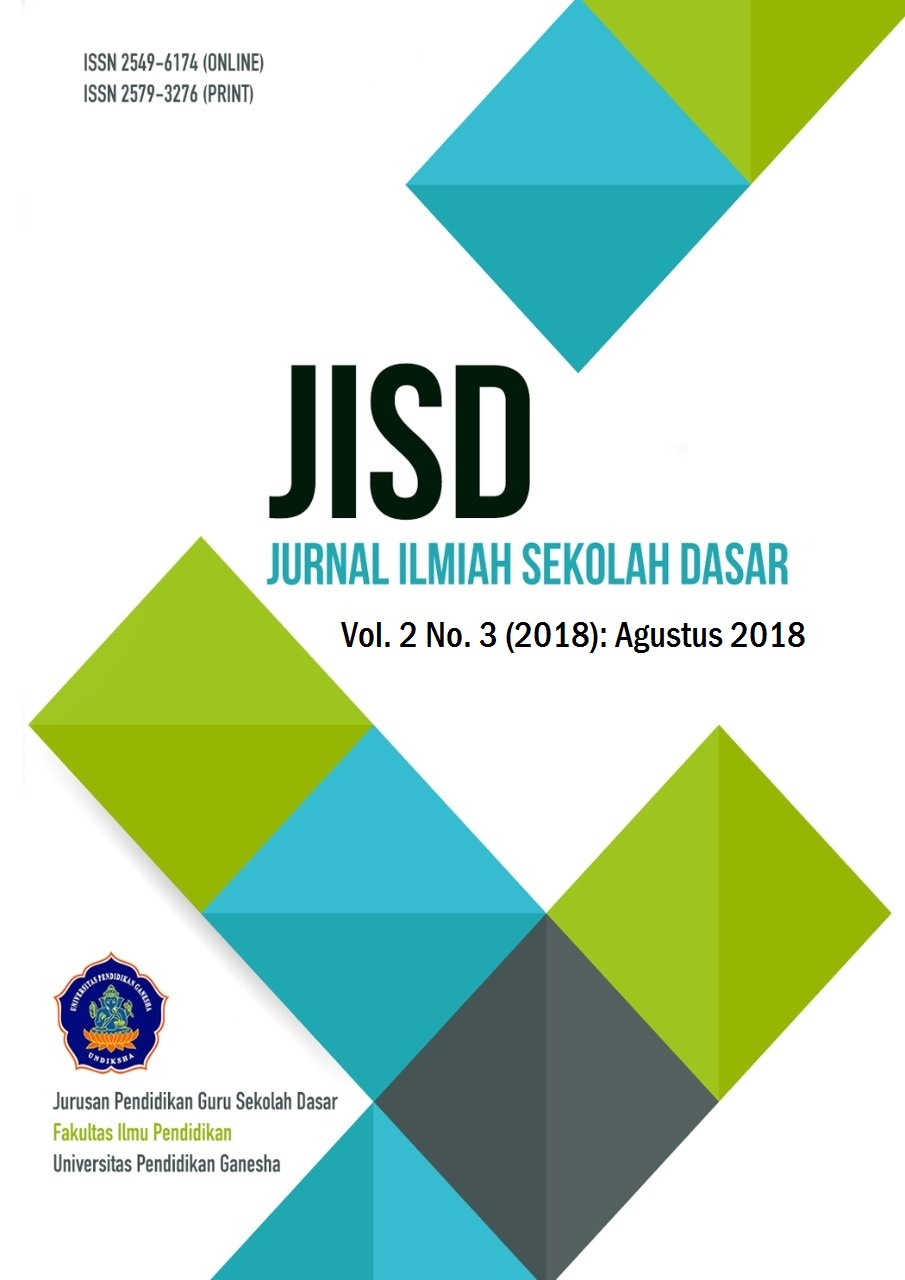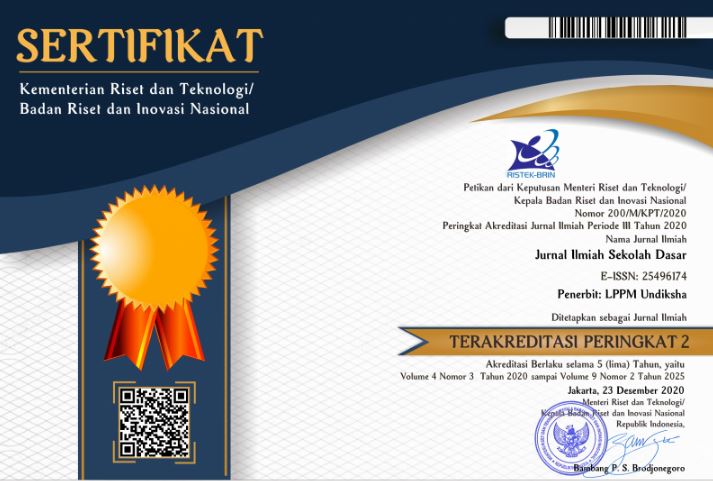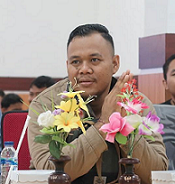Kontribusi Gaya Belajar Dan Motivasi Belajar Terhadap Hasil Belajar Bahasa Indonesia
DOI:
https://doi.org/10.23887/jisd.v2i3.16140Abstrak
The aim of this study to know the contribution of learning styles and motivation of learning in result of learning Bahasa Indonesia in fifth grade student of SD Negeri Ularan Seririt Subdistrict in academic year 2017/2018. This study was ex-post facto research with total population as well as sample of 37 people. The data were collected through taking note document tecnique and questionnaire learning style and motivation of learning instrument. The data were analyzed in two steps, with descriptive statistic analysis and inferential statistic analysis through simple regression test and multiple regression test. The results showed that 1) learning style contribute 47.3% toward the result of learning Bahasa Indonesia as subject, 2) motivation of learning contribute 45.3% toward the result of learning Bahasa Indonesia as subject, 3) learning styles and motivation of learning contribute 62.8% in resulting of Bahasa Indonesia. In Contributing learning style and motivation of learning toward resulting of Bahasa Indonesia showed learning style and motivation of learning that was influential in resulting of the study Bahasa Indonesia at fifth grade students of SD Negeri Ularan Seririt Subdistrict in academic year 2017/2018Referensi
Aunurrahman. 2013. Belajar dan Pembelajaran. Bandung: Alfabetha.
Baharuddin, H. dan Esa N.W. 2010. Teori Belajar dan Pembelajaran. Jogjakarta: Ar-Ruzz Media.
Bintarini, N.K. 2013. “Determinasi Pemanfaatan Lingkungan Sekitar Sekolah Sebagai Sumber Belajar Terhadap Gaya Belajar Dan Pemahaman Konsep IPS pada Siswa Kelas IV SDN Gugus Yudistira Kecamatan Negara”. e-Jurnal Pascasarjana Universitas Pendidikan Ganesha. Volume 3.
Dedi, R. “Pengaruh Motivasi Belajar, Gaya Belajar dan Kemandirian Belajar terhadap Hasil Belajar Mahasiswa S1 PGSD Masukan Sarjana di UPBJJ UT Bandung”. Jurnal Pendidikan Dasar. Volume 8, Nomor 2.
DePorter, B. dan Mike H. 2007. Quantum Learning:Membiasakan Belajar Nyaman dan Menyenangkan. Terjemahan Alwiyah Abdurrahman. Quantm Learning: Unleashing the Genius In You. 1992. Cetakan ke-24. Bandung: Mizan Pustaka.
Djamarah, S. B. dan Aswan Z. 2002. Strategi Belajar Mengajar. Jakarta: Rineka Cipta.
Hanafiah, N. dan Cucu S. 2012. Konsep Strategi Pembelajaran. Bandung: Refika Aditama
Hariani, V. 2016. “Kontribusi Gaya Belajar Dan Motivasi Belajar Siswa Terhadap Hasil Belajar Pada Mata Pelajaran TIK Siswa Kelas VIII SMP Kartika 1-6 Padang”. Universitas Bung Hatta.
Khoeron, I. R. 2014. “Pengaruh Gaya Belajar terhadap Prestasi Belajar Peserta Didik pada Mata Pelajaran Produktif”. Pendidikan Teknik Mesin Universitas Pendidikan Indonesia. Volume 1, Nomor 2.
Papilaya, J. O. 2016. “Indentifikasi Gaya Belajar Mahasiswa”. Jurnal Psikologi UNDIP. Volume 15, Nomor 1.
Rahman, A. A. 2016. “Pengaruh Gaya Belajar Terhadap Hasil Belajar Siswa Pada Mata Pelajaran IPS Terpadu di Kelas VII SMP Negeri 1 Peudada”. Jurnal Pendidikan Almuslim. Volume IV, Nomor 2.
Rejeki, S. 2012. “Pengaruh Kondisi Ekonomi Keluarga, Motivasi belajar, dan Gaya Belajar Terhadap Hasil Belajar Siswa. FKIP Universitas Sebelas Maret.
Susanto, A. 2013. Teori Belajar dan pembelajaran di Sekolah Dasar. Jakarta: Kencana.
Suwatra, I W, dkk. 2015. Belajar dan Pembelajaran Sekolah Dasar. Singaraja: Universitas Pendidikan Ganesha.
Sutikno, M. S.2005. Pembelajaran Efektif Mataram. NTP Press.
Syafsensi, Ice. 2013. “Kontribusi Motivasi Belajar terhadap Hasil Belajar Mata Pelajaran Gambar Bangunan Siswa SMK Negeri 2 Solok”. Pendidikan Teknik Bangunan FT UNP. Volume 1, Nomor 1.
Undang-Undang Republik Indonesia Nomor 20 Tahun 2003 tentang Sistem Pendidikan Nasional. Tersedia pada https://kemenag.go.id/file/dokumen/UU2003.pdf (diakses pada tanggal 12 Desember 2017)
Uno, H. B . 2016. Teori Motivasi dan Pengukurannya. Jakarta: Bumi Aksara.
Uno, H.B. 2007. Teori Motivasi dan Pengukurannya. Cetakan ke-3. Jakarta: Bumi Aksara
Unduhan
Diterbitkan
Cara Mengutip
Terbitan
Bagian
Lisensi
Authors who publish with the Journal Ilmiah Sekolah Dasar agree to the following terms:
- Authors retain copyright and grant the journal the right of first publication with the work simultaneously licensed under a Creative Commons Attribution License (CC BY-SA 4.0) that allows others to share the work with an acknowledgment of the work's authorship and initial publication in this journal.
- Authors are able to enter into separate, additional contractual arrangements for the non-exclusive distribution of the journal's published version of the work (e.g., post it to an institutional repository or publish it in a book), with an acknowledgment of its initial publication in this journal.
- Authors are permitted and encouraged to post their work online (e.g., in institutional repositories or on their website) prior to and during the submission process, as it can lead to productive exchanges, as well as earlier and greater citation of published work. (See The Effect of Open Access)










